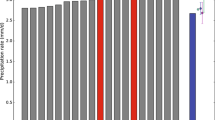Abstract
The fractional water vapor changes under global warming across 14 Coupled Model Intercomparison Project Phase 5 simulations are analyzed. We show that the mean fractional water vapor changes under global warming in the tropical upper troposphere between 300 and 100 hPa range from 12.4 to 28.0 %/K across all models while the fractional water vapor changes are about 5–8 %/K in other regions and at lower altitudes. The “upper-tropospheric amplification” of the water vapor change is primarily driven by a larger temperature increase in the upper troposphere than in the lower troposphere per degree of surface warming. The relative contributions of atmospheric temperature and relative humidity changes to the water vapor change in each model vary between 71.5 to 131.8 % and 24.8 to −20.1 %, respectively. The inter-model differences in the water vapor change is primarily caused by differences in temperature change, except over the inter-tropical convergence zone within 10°S–10°N where the model differences due to the relative humidity change are significant. Furthermore, we find that there is generally a positive correlation between the rates of water vapor change for long-tem surface warming and those on the interannual time scales. However, the rates of water vapor change under long-term warming have a systematic offset from those on the inter-annual time scales and the dominant contributor to the differences also differs for the two time scales, suggesting caution needs to be taken when inferring long-term water vapor changes from the observed interannual variations.











Similar content being viewed by others
References
de Forster PMF, Collins M (2004) Quantifying the water vapourfeedback associated with post-Pinatubo global cooling. Clim Dyn 23:207–214
Dessler AE, Zhang Z, Yang P (2008) Water-vapor climate feedback inferred from climate fluctuations, 2003–2008. Geophys Res Lett 35:L20704. doi:10.1029/2008GL035333
Dessler AE, Sherwood SC (2009) A matter of humidity. Science 323:1020–1021
Dessler AE, Wong S (2009) Estimates of the water vapor climate feedback during El Niño-Southern oscillation. J Clim 22:6404–6412. doi:10.1175/2009JCLI3052.1
Fasullo JT, Trenberth KE (2012) A less cloudy future: the role of subtropical subsidence in climate sensitivity. Science 338:792–794
Fueglistaler S, Dessler AE, Dunkerton TJ, Folkins I, Fu Q, Mote PW (2009) Tropical tropopause layer. Rev. Geophys. 47:RG1004. doi:10.1029/2008RG000267
Goody RM, Yung YL (1989) Atmospheric radiation: theoretical basis, 2nd ed. Oxford University Press, p 519
Jiang JH, Su H, Zhai C, Perun VS, Del Genio A, Nazarenko LS, Donner LJ, Horowitz L, Seman C, Cole J, Gettelman A, Ringer M, Rotstayn L, Jeffrey S, Wu T, Brient F, Dufresne J-L, Kawai H, Koshiro T, Watanabe M, LÉcuyer TS, Volodin EM, Iversen T, Drange H, Mesquita MS, Read WG, Waters JW, Tian B, Teixeira J, Stephens GL (2012) Evaluation of cloud and water vapor simulations in CMIP5 climate models using NASA A-train satellite observations. J Geophys Res 117, D1410, 24. doi:10.1029/2011JD017237
Lau WK, Kim K-M (2015) Robust Hadley Circulation changes and increasing global dryness due to CO2 warming from CMIP5 model projections. PNAS, Early Edition (1–6). doi: 10.1073/pnas.1418682112
Manabe S, Wetherald RT (1967) Thermal equilibrium of atmosphere with a given distribution of relative humidity. J Atmos Sci 24:241–259
Meinshausen M et al (2011) The RCP greenhouse gas concentrations and their extension from 1765 to 2300. Clim Change 109:213–241. doi:10.1007/s10584-011-0156-z
Minschwaner K, Dessler AE (2004) Water vapor feedback in the tropical upper troposphere: Model results and observations. J Clim 17:1272–1282
Ramaswamy V, Schwarzkopf MD, Randel WJ, Santer BD, Soden BJ, Stenchikov G (2006) Anthropogenic and natural influences in the evolution of lower stratospheric cooling. Science 311:1138–1141
Randall DA et al (2007) Climate models and their evaluation. In: Solomon S et al (eds) Climate change 2007: the physical science basis. Contributions of working group I to the fourth assessment report of the intergovernmental panel on climate change. Cambridge University Press, Cambridge, UK, pp 591–662
Sherwood SC, Bony S, Dufresne J-L (2014) Spread in model climate sensitivity traced to atmospheric convective mixing. Nature 505:37–42. doi:10.1038/nature12829
Soden BJ, Held IM (2006) An assessment of climate feedbacks in coupled ocean-atmosphere models. J Clim 19:3354–3360
Soden BJ, Held IM, Colman R, Shell KM, Kiehl JT, Shields CA (2008) Quantifying climate feedbacks using radiative kernels. J Clim 21:3504–3520
Soden BJ, Jackson DL, Ramaswamy V, Schwarzkopf MD, Huang X (2005) The radiative signature of upper tropospheric moistening. Science. doi:10.1126/science.1115602
Su H, Jiang JH, Zhai C, Shen TJ, Neelin JD, Stephens GL, Yung YL (2014) Weakening and strengthening structures in the Hadley Circulation change under global warming and implications for cloud response and climate sensitivity. J Geophys Res Atmos 119:5787–5805. doi:10.1002/2014JD021642
Takahashi H, Su H, Jiang JH (2015) Error analysis of upper tropospheric water vapor in CMIP5 models using “A-Train” satellite observations and reanalysis data. Clim Dyn. doi:10.1007/s00382-015-2732-9
Taylor KE, Stouffer RJ, Meehl GA (2012) An overview of CMIP5 and the experiment design. Bull Am Meteorol Soc 93:485–498. doi:10.1175/BAMS-D-11-00094.1
Tian BJ (2015) Spread of model climate sensitivity linked to double-intertropical convergence zone bias. Geophys Res Lett. doi:10.1002/2015GL064119
Udelhofen PM, Hartmann DL (1995) Influence of tropical cloud systems on the relative humidity in the upper troposphere. J Geophys Res 100. doi:10.1029/94JD02826
Vial J, Dufresne J-L, Bony S (2013) On the interpretation of inter-model spread in CMIP5 climate sensitivity estimates. Clim Dyn 41:3339–3362. doi:10.1007/s00382-013-1725-9
Zhai C, Jiang JH, Su H (2015) Long term cloud change imprinted in seasonal cloud variation: more evidence of high climate sensitivity. Geophys Res Lett 42:8729–8737. doi:10.1002/2015GL065911
Acknowledgments
The authors appreciate the funding support by NASA ROSES AST, NEWS, MAP and NDOA programs. We are also grateful to Mark Richardson and two anonymous reviewers for their valuable comments. This work is performed at the Jet Propulsion Laboratory, California Institute of Technology, under contract with NASA.
Author information
Authors and Affiliations
Corresponding author
Rights and permissions
About this article
Cite this article
Takahashi, H., Su, H. & Jiang, J.H. Water vapor changes under global warming and the linkage to present-day interannual variabilities in CMIP5 models. Clim Dyn 47, 3673–3691 (2016). https://doi.org/10.1007/s00382-016-3035-5
Received:
Accepted:
Published:
Issue Date:
DOI: https://doi.org/10.1007/s00382-016-3035-5




